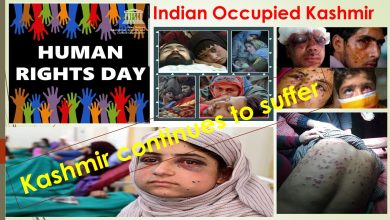 In the current era of globalization and complex interdependence, where various aspects such as political, socioeconomic, technological, and cultural integration play a significant role, there exists a potential for unity in diversity. However, the Hindutva-based ideological discourse in India, characterized by fascist and extremist tendencies, aims to permanently occupy and suppress the right to self-determination of the Kashmiri people. To materialize this strategy it is a common pattern for occupying forces to engage in cultural genocide when seeking to permanently occupy a territory.
In the current era of globalization and complex interdependence, where various aspects such as political, socioeconomic, technological, and cultural integration play a significant role, there exists a potential for unity in diversity. However, the Hindutva-based ideological discourse in India, characterized by fascist and extremist tendencies, aims to permanently occupy and suppress the right to self-determination of the Kashmiri people. To materialize this strategy it is a common pattern for occupying forces to engage in cultural genocide when seeking to permanently occupy a territory.
Culture plays a profound role in identifying various causes, particularly in indigenous movements of resistance and resilience. Its influence extends from local settings to the international arena, contributing to peace-building efforts and maintaining global structures.
Raphael Lemkin, a Polish lawyer, came up with the term ‘cultural genocide’ along with the idea of genocide itself. He saw cultural genocide as a way to carry out genocide by targeting a group’s culture, like destroying its cultural symbols or practices. It’s like a method to wipe out a group’s identity by attacking what makes their culture unique.
The concept of cultural hegemony and its impact on power dynamics on a global scale is significant within the realms of social sciences and humanities, notably in the field of international relations. Scholars like Gramsci emphasize the elite’s ability to control society through culture and ideology, often manifested through institutions that influence foreign policy and the establishment of international political orders. Occupying powers attempt to suppress or permanently occupy others by initially undermining and dismantling their cultural heritage.
Nevertheless, the concepts of cultural hegemony and cultural genocide run in a parallel manner. To have cultural hegemony, fascist regimes aimed to eradicate cultural chronicles of the oppressed and subjugated ones. The example of Indian illegally occupied Jammu and Kashmir is in front of us. One of the most highly militarized zones in the world that has been the victim of illegitimate Indian occupation. After the abrogation of article 370 and 35a, the suppression of the Kashmiris has been raised. India has been claiming that the major agenda behind ending the special status of the occupied Jammu and Kashmir is to develop it. However, the objective reality depicts that the core endeavor was to mitigate the freedom movement and that the freedom movement is still ongoing and has just transferred from Kashmir valley to the Jammu region. India is just trying to portray fake normalcy.
In addition, this is also evident that in post-2019 time, the situation of occupied Kashmir worsened. The implementation of draconian laws, incorporation of neo-settler colonialism, illegitimate demographic changes, and human rights violations are at their peak. For the permanent settlement in the occupied territory, occupiers bring demographic changes. In the case of the disputed region of Jammu and Kashmir, the illegitimate abrogation of articles 370 and 350A reflects the atrocity of demographic changes. India is attempting such heinous acts to strengthen her sovereignty and to subdue Kashmir’s right to self-determination. The extension of domicile to Indians has increased at a drastic rate. In addition, colonizers use the tool of religious nationalism to justification of their colonial project. The ultimate endeavor of the Modi regime is to materialize the Hindutva discourse.
In this way, they are suppressing the religious identities of Kashmiri Muslims and they are intensively promoting pilgrimages such as Amarnath Yatra to reinforce the idea of Kashmir being an integral part of India. To discount how the occupation took place, colonizers create legitimacy for their illegal occupation by rewriting histories and knowledge production. In the same way, India has been trying to abolish centuries-old religious places like mosques in occupied Kashmir.
The illegitimate demographic changes by India violated the United Nations Charter and Geneva Conventions. According to Article 47 of IV Geneva Convention, one of the important principles of international humanitarian law is that the occupier cannot occupy a territory but rather places obligations to rule the territory without demographic changes, respecting political and other institutions. According to Article 49 of IV Geneva Convention, the occupier could not transfer its civilians into occupied territory and could not transform the demographics of the territory to claim sovereignty and undermine the right to self-determination. But, India violated the Articles of the Geneva Convention. India’s unilateral and illegitimate initiatives will not only change the demographics of occupied Kashmir but also adversely affect the socioeconomic dynamics and political participation of indigenous Kashmiris in their native land.
From the early days, there has been a history of extremist Hindus oppressing Muslims. Instances of blasphemy during the Dogra rule and the deterioration of Muslim cultural heritage were prevalent but intangible forms of harm. The Jammu genocide of 1947 orchestrated by the RSS aimed to strategically convert the Muslim majority state into a minority, representing a tangible form of genocide. These historical events are linked to the current situation, where India’s actions suggest a dual approach to genocide, targeting both tangible and intangible aspects to solidify control over occupied territories. This pattern reflects a concerning strategy aimed at altering demographics and cultural landscapes to maintain occupation and dominance.
India’s current policies extend beyond just the situation in Indian-illegally occupied Jammu and Kashmir; they also impact domestic regions like Manipur and Assam. The bulldozer politics of Chief Minister Yogi Adityanath in Uttar Pradesh reflects a trend of forceful governance. Observers note a shift in India’s traditional stance of religious tolerance. This shift raises concerns about the country’s commitment to secular principles and the treatment of minority groups within its borders. By examining these case studies, one can discern a broader pattern of policy implementation that warrants critical analysis and international attention.









